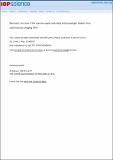Files in this item
Electronic structure of the cuprate superconducting and pseudogap phases from spectroscopic imaging STM
Item metadata
| dc.contributor.author | Schmidt, A. R. | |
| dc.contributor.author | Fujita, K. | |
| dc.contributor.author | Kim, E-A | |
| dc.contributor.author | Lawler, M. J. | |
| dc.contributor.author | Eisaki, H. | |
| dc.contributor.author | Uchida, S. | |
| dc.contributor.author | Lee, D-H | |
| dc.contributor.author | Davis, J. C. | |
| dc.date.accessioned | 2014-01-20T10:31:01Z | |
| dc.date.available | 2014-01-20T10:31:01Z | |
| dc.date.issued | 2011-06-21 | |
| dc.identifier | 19658991 | |
| dc.identifier | fcd1b855-a81c-441d-80e0-0f9d9fad8fb6 | |
| dc.identifier | 000292140900001 | |
| dc.identifier | 79959637265 | |
| dc.identifier.citation | Schmidt , A R , Fujita , K , Kim , E-A , Lawler , M J , Eisaki , H , Uchida , S , Lee , D-H & Davis , J C 2011 , ' Electronic structure of the cuprate superconducting and pseudogap phases from spectroscopic imaging STM ' , New Journal of Physics , vol. 13 , 065014 . https://doi.org/10.1088/1367-2630/13/6/065014 | en |
| dc.identifier.issn | 1367-2630 | |
| dc.identifier.uri | https://hdl.handle.net/10023/4399 | |
| dc.description.abstract | We survey the use of spectroscopic imaging scanning tunneling microscopy (SI-STM) to probe the electronic structure of underdoped cuprates. Two distinct classes of electronic states are observed in both the d-wave superconducting (dSC) and the pseudogap (PG) phases. The first class consists of the dispersive Bogoliubov quasiparticle excitations of a homogeneous d-wave superconductor, existing below a lower energy scale E = Delta(0). We find that the Bogoliubov quasiparticle interference (QPI) signatures of delocalized Cooper pairing are restricted to a k-space arc, which terminates near the lines connecting k = +/-(pi/a(0), 0) to k = +/-(0, pi/a(0)). This arc shrinks continuously with decreasing hole density such that Luttinger's theorem could be satisfied if it represents the front side of a hole-pocket that is bounded behind by the lines between k = +/-(pi/a(0), 0) and k = +/-(0, pi/a(0)). In both phases, the only broken symmetries detected for the vertical bar E vertical bar < Delta(0) states are those of a d-wave superconductor. The second class of states occurs proximate to the PG energy scale E = Delta(1). Here the non-dispersive electronic structure breaks the expected 90 degrees-rotational symmetry of electronic structure within each unit cell, at least down to 180 degrees-rotational symmetry. This electronic symmetry breaking was first detected as an electronic inequivalence at the two oxygen sites within each unit cell by using a measure of nematic (C-2) symmetry. Incommensurate non-dispersive conductance modulations, locally breaking both rotational and translational symmetries, coexist with this intra-unit-cell electronic symmetry breaking at E = Delta(1). Their characteristic wavevector Q is determined by the k-space points where Bogoliubov QPI terminates and therefore changes continuously with doping. The distinct broken electronic symmetry states (intra-unit-cell and finite Q) coexisting at E similar to Delta(1) are found to be indistinguishable in the dSC and PG phases. The next challenge for SI-STM studies is to determine the relationship of the E similar to Delta(1) broken symmetry electronic states with the PG phase, and with the E < Delta(0) states associated with Cooper pairing. | |
| dc.format.extent | 32 | |
| dc.format.extent | 4376928 | |
| dc.language.iso | eng | |
| dc.relation.ispartof | New Journal of Physics | en |
| dc.subject | Spectroscopic imaging scanning tunneling microscopy (SI-STM) | en |
| dc.subject | Underdoped cuprates | en |
| dc.subject | D-wave superconducting (dSC) | en |
| dc.subject | Pseudogap (PG) phases | en |
| dc.title | Electronic structure of the cuprate superconducting and pseudogap phases from spectroscopic imaging STM | en |
| dc.type | Journal article | en |
| dc.contributor.institution | University of St Andrews. School of Physics and Astronomy | en |
| dc.contributor.institution | University of St Andrews. Condensed Matter Physics | en |
| dc.identifier.doi | 10.1088/1367-2630/13/6/065014 | |
| dc.description.status | Peer reviewed | en |
This item appears in the following Collection(s)
Items in the St Andrews Research Repository are protected by copyright, with all rights reserved, unless otherwise indicated.

